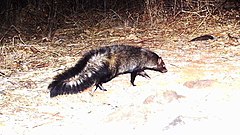Warcz (rodzaj ssaków)
| Bdeogale | |||
| W. Peters, 1850[1] | |||
 Przedstawiciel rodzaju – warcz gruboogonowy (B. crassicauda) | |||
| Systematyka | |||
| Domena | eukarionty | ||
|---|---|---|---|
| Królestwo | zwierzęta | ||
| Typ | strunowce | ||
| Podtyp | kręgowce | ||
| Gromada | ssaki | ||
| Podgromada | żyworodne | ||
| Infragromada | |||
| Rząd | drapieżne | ||
| Podrząd | kotokształtne | ||
| Infrarząd | Viverroidea | ||
| Rodzina | mangustowate | ||
| Podrodzina | Herpestinae | ||
| Rodzaj | warcz | ||
| Typ nomenklatoryczny | |||
| Bdeogale crassicauda W. Peters, 1852 | |||
| Synonimy | |||
| | |||
| Gatunki | |||
| |||
| Zasięg występowania | |||
 Bdeogale nigripes Bdeogale jacksoni Bdeogale crassicauda | |||
| |||
| |||
Warcz[4] (Bdeogale) – rodzaj ssaków z podrodziny Herpestinae w obrębie rodziny mangustowatych (Herpestidae).
Zasięg występowania
Rodzaj obejmuje gatunki zamieszkujące lasy deszczowe środkowej i wschodniej Afryki[5][6][7].
Morfologia
Długość ciała 40–65 cm, ogona 18–40 cm, tylnej łapy 7–11,5 cm, ucha 2–3,9 cm; masa ciała 1,3–4,8 kg[6][8].
Systematyka
Rodzaj zdefiniował w 1850 roku niemiecki zoolog Wilhelm Peters na łamach Spenersche Zeitung[1]. Peters nie wskazał gatunku typowego; w ramach późniejszego oznaczenia w 1882 roku angielski zoolog Oldfield Thomas na typ nomenklatoryczny wyznaczył Bdeogale crassicauda W. Peters, 1852 (warcz gruboogonowy)[9].
Etymologia
- Bdeogale (Beleogale): gr. βδεέιν bdeēin ‘śmierdzieć’; γαλεή galeē lub γαλή galē ‘łasica’[10].
- Galeriscus: rodzaj Galera Browne, 1789 (hirara); łac. przyrostek zdrabniający -iscus[11]. Gatunek typowy (oznaczenie monotypowe): Galeriscus jacksoni O. Thomas, 1894.
Podział systematyczny
Do rodzaju należą następujące gatunki[12][8][5][4]:
- Bdeogale crassicauda W. Peters, 1852 – warcz gruboogonowy
- Bdeogale omnivora E. Heller, 1913 – warcz nadbrzeżny
- Bdeogale nigripes Pucheran, 1855 – warcz czarnołapy
- Bdeogale jacksoni (O. Thomas, 1894) – warcz masajski
Uwagi
- ↑ Niepoprawna późniejsza pisownia Bdeogale W. Peters, 1850.
Przypisy
- ↑ a b W. Peters. [Bez tytułu]. „Spenersche Zeitung”. 25 lipca, s. 81–82, 1850. (niem.).
- ↑ A.F. Marshall: Nomenclator zoologicus continens nomina systematica generum animalium tam viventium quam fossilium, secundum ordinem alphabeticum disposita. Vindobonae: typis C. Ueberreuter (M. Salzer), 1873, s. 3. (łac.).
- ↑ O. Thomas. On a new African Genus of Mustelidae. „The Annals and Magazine of Natural History”. Sixth Series. 13, s. 522, 1894. (ang.).
- ↑ a b W. Cichocki, A. Ważna, J. Cichocki, E. Rajska-Jurgiel, A. Jasiński & W. Bogdanowicz: Polskie nazewnictwo ssaków świata. Warszawa: Muzeum i Instytut Zoologii PAN, 2015, s. 143. ISBN 978-83-88147-15-9. (pol. • ang.).
- ↑ a b C.J. Burgin, D.E. Wilson, R.A. Mittermeier, A.B. Rylands, T.E. Lacher & W. Sechrest: Illustrated Checklist of the Mammals of the World. Cz. 2: Eulipotyphla to Carnivora. Barcelona: Lynx Edicions, 2020, s. 414. ISBN 978-84-16728-35-0. (ang.).
- ↑ a b J.S. Gilchrist, A.P. Jennings, G. Veron, P. Cavallini (koordynator): Family Herpestidae (Mongooses). W: D.E. Wilson, R.A. Mittermeier (redaktorzy): Handbook of the Mammals of the World. Cz. 1: Carnivores. Barcelona: Lynx Edicions, 2009, s. 318–319. ISBN 978-84-96553-49-1. (ang.).
- ↑ D.E. Wilson & D.M. Reeder (redaktorzy): Bdeogale. [w:] Mammal Species of the World. A Taxonomic and Geographic Reference (Wyd. 3) [on-line]. Johns Hopkins University Press, 2005. [dostęp 2019-10-01].
- ↑ a b Class Mammalia. W: Lynx Nature Books: All the Mammals of the World. Barcelona: Lynx Edicions, 2023, s. 656. ISBN 978-84-16728-66-4. (ang.).
- ↑ O. Thomas. On the African mungooses. „Proceedings of the Zoological Society of London”. 1882 (1), s. 81, 1882. (ang.).
- ↑ Palmer 1904 ↓, s. 135.
- ↑ Palmer 1904 ↓, s. 289.
- ↑ N. Upham, C. Burgin, J. Widness, M. Becker, C. Parker, S. Liphardt, I. Rochon & D. Huckaby: Treeview of Mammalian Taxonomy Hierarchy. [w:] ASM Mammal Diversity Database (Version 1.11) [on-line]. American Society of Mammalogists. [dostęp 2023-12-15]. (ang.).
Bibliografia
- T.S. Palmer. Index Generum Mammalium: a List of the Genera and Families of Mammals. „North American Fauna”. 23, s. 1–984, 1904. (ang.).










